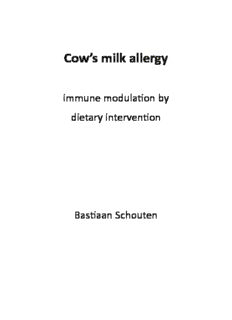
Cow's milk allergy PDF
Preview Cow's milk allergy
Cow’s milk allergy immune modulation by dietary intervention Bastiaan Schouten ISBN/EAN: 978-90-393-5210-6 Cover photo, design and thesis lay-out: Bastiaan Schouten Printed by: GVO | Ponsen & Looijen B.V., Ede, The Netherlands The printing of this thesis was financially supported by: Danone Research – Centre for Specialised Nutrition, J.E. Jurriaanse Stichting, Utrecht Institute for Pharmaceutical Sciences, TNO / Utrecht Center for Food Allergy, Infection & Immunity Center Utrecht, BD Biosciences, FrieslandCampina Domo © 2009 Bastiaan Schouten All rights reserved. No part of this thesis may be reproduced or transmitted in any form, by any means, electronic or mechanical, without prior written permission of the author. Cow’s milk allergy immune modulation by dietary intervention Koemelkallergie immuunmodulatie door dieetinterventie (met een samenvatting in het Nederlands) Proefschrift ter verkrijging van de graad van doctor aan de Universiteit Utrecht op gezag van de rector magnificus, prof.dr. J.C. Stoof, ingevolge het besluit van het college voor promoties, in het openbaar te verdedigen op woensdag 25 november 2009 des middags te 2.30 uur door Bastiaan Schouten geboren op 27 februari 1981 te Utrecht Promotor: Prof.dr. J. Garssen Co-promotoren: Dr. L.E.M. Willemsen Dr. L.M.J. Knippels C ontents Chapter 1 General introduction 9 Chapter 2 Nutrition and food allergy 25 Chapter 3 Acute allergic skin reactions and intestinal contractility 55 changes in mice orally sensitized against casein or whey Chapter 4 Contribution of IgE and immunoglobulin free light chain in 77 the allergic reaction to cow’s milk proteins Chapter 5 Non-digestible oligosaccharides reduce immunoglobulin 95 free light-chain levels in infants at risk for allergies Chapter 6 Cow’s milk allergy symptoms are reduced in mice fed 103 dietary synbiotics during oral sensitization with whey Chapter 7 Oligosaccharide induced whey-specific CD25+ regulatory 119 T-cells are crucial in the suppression of cow’s milk allergy in mice Chapter 8 Dietary non-digestible carbohydrates inhibit the allergic 141 effector response via induction of casein-specific CD25+ regulatory T-cells in orally sensitized mice Chapter 9 iNKT cells contribute to the allergic response in cow’s milk 163 protein sensitized mice Chapter 10 General discussion 181 Miscellaneous 197 Summary 198 Nederlandse samenvatting 202 Dankwoord 207 Curriculum Vitae 212 List of publications 213 Abbreviations 217 1 General introduction General Introduction 1 T he adaptive immune response and regulatory T-cells The human body is continuously under attack by all kinds of microbes like bacteria, fungi, parasites and viruses and has at least three different parts to overcome these invaders. The first is a physicochemical barrier, the epithelial lining of the skin, respiratory and intestinal mucosa forming intrinsic tight junctions which prevent paracellular passage of antigenic particles. In the intestinal and respiratory mucosa the mucus layer forms an extrinsic barrier, preventing direct contact of the microbes with the epithelial lining. The second line of defense is the innate immune system, which comprises the complement system, natural killer cells, basophils, neutrophils and eosinophils, they are rigid and attack pathogens non-specific. The adaptive immune system forms the third immune defense and can be divided in a humoral and a cellular part which are able to recognize and remember specific antigens. In allergic individuals an adaptive immune response is generated towards a harmless antigen. In food allergic patients immunity instead of oral tolerance is raised towards food proteins. This results in a T 2 type effector immune response and, more H chronically, involves an allergen specific T 1 response [1]. Other effector cells like T 17, T 3 H H H and others have not been implicated in the pathology of cow’s milk allergy. Tolerance or immunity to food antigens is generated in the gut associated lymphoid tissue (GALT) (Figure 1). The Peyer’s patches (PP) and mesenteric lymph nodes (MLN) are the inductive sites of the GALT, here immunity or oral tolerance is induced. Food proteins can induce clonal deletion or anergy (high dose tolerance), rendering cells non-responsive for the antigen, or active suppression by regulator T-cells (Treg cells) (low dose tolerance) [2]. Antigens are taken up by dendritic cells (DC) in the PP or lamina propria and travel to the MLN [3]. In the MLN and PP, DC present antigens to naïve T-cells and induce tolerance (anergy/deletion or suppression by Treg cells) or an effector response against the antigen. Antigen-responsive T-cells (CD4+) leave the MLN, travel subsequently through the bloodstream and home back into the intestinal mucosa (lamina propria) and transfer to the peripheral immune system (e.g. spleen) [2, 3]. Different Treg cell subsets are able to actively suppress effector T-cell responses and regulate immune homeostasis of the GALT. Antigen specific T-cells or Treg cells from the MLN in this respect can relocate local induced immune responses to the periphery. Cytokines produced by allergic T 2 effector cells instruct isotype switching and H maturation of B cells resulting in immunoglobulin (Ig)E production in human and in mice both IgE and IgG antibodies were produced against this allergen. These antibodies bind to 1 Fc receptors on mast cells and after a second allergen exposure, receptor crosslinking results in mast cell activation and degranulation. Mast cell mediator release such as histamine and leukotriens cause the acute allergic symptoms like eczema, diarrhea, asthma and in some cases anaphylaxis. The humoral response of the murine adaptive immune system is complex and covers both 10
Description: